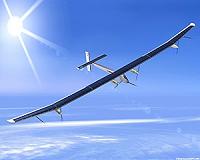 |
Payerne, Switzerland (AFP) July 8, 2010 His grandfather soared to the highest altitude reached by men in a balloon while his father travelled to the deepest point underwater. Bertrand Piccard himself circled the globe in the first non-stop hot-air balloon flights in 1999. But the Swiss adventurer has now added another record to his illustrious family name with his solar-powered plane project Solar Impulse, which on Thursday completed a pioneering non-stop flight through day and night. In an interview with AFP, Piccard explained where he acquired his taste for adventure. "It comes from the taste for exploring the unknowns, exploring new domains, going further than we imagine is possible," he said. "It's what I have seen throughout my childhood with my grandfather and my father, and it's true that's what interests me in life." His father, Jacques Piccard, holds the record for travelling to the deepest point underwater. Jacques -- who died in 2008 at the age of 85 -- and US Navy officer Don Walsh reached the bottom of the Mariana Trench, 10,916 metres (35,813 feet) below sea level on January 23, 1960 -- the farthest point underwater in a bathyscaphe submarine. He also built four submarines, including the first tourist submarine that carried passengers deep into Lake Geneva in 1964 and carried on deep sea exploration up to the age of 82. Dubbed Captain Nemo, Jacques Piccard witnessed living organisms at a depth of over 11,000 metres below sea level, a discovery that led to a ban in nuclear waste dumping into the ocean. Bertrand's grandfather, Auguste Piccard, twice beat the record for reaching the highest altitude in a balloon, in 1931-32, and invented the bathyscaphe. Tintin's creator Herge modelled the character Professor Cuthbert Calculus in the comic series after Auguste. The physicist was also deeply interested in harnessing solar energy. "My grandfather had written in 1943 in a major scientific article on photovoltaic energy," noted Piccard. "I had always heard my father and grandfather talking about their environmental concerns. For them, it was very important to protect the environment and to use technology to do so," the 51-year-old recalled. "Today, this technology exists, that's finally the big difference. In the past we hoped to find these solutions while today these solutions exist." Piccard started conceiving the idea of a solar plane after completing his pioneering non-stop round the world flight in a hot-air balloon with Briton Brian Jones in 1999. He explained that the duo had embarked on their flight with 3.7 tonnes of liquid propane, but landed with just 40 kilogrammes. "I told myself, it's not sustainable. I would have liked to remain in flight as long as I wished and to fly without fuel. The idea came at this moment." Over the past seven years, the adventurer assembled a 70-strong team to develop Solar Impulse, a lightweight aircraft with a wingspan comparable to a jumbo jet that bears 12,000 solar cells to harness the sun's power. For Piccard, "the goal is to take to the air with no fuel. The goal is to show that we can be much more independent from fossil energy than people usually think." "Eleven years ago, technologies to lower the impact on the environment, the technologies for saving fossil fuels were not so efficient. That was the beginning. "Now we have the capacity of the clean technology that is available, but it is not used often because there is a lack of political will to push it." He noted that if governments were to impose fuel consumption limits on vehicles, it could drive manufacturers to produce greener cars. "Other examples are the insulation of buildings -- if you insulate all homes, you give work to many people. You boost the economy and at the same time, you save a lot of energy in your home. "And that's profitable -- you can make more money than at the stock market if you insulate your home," he claimed. With Solar Impulse's overnight flight out of the way, Piccard is setting his sights on the prospect of transatlantic and round the world flights in 2013-2014. He stressed that "solar is a way of talking about" environmental challenges and the potential of clean energy. "It's a way of motivating people," he said.
Share This Article With Planet Earth
Related Links Aerospace News at SpaceMart.com
 Solar Impulse plane packed with technology
Solar Impulse plane packed with technologyPayerne, Switzerland (AFP) July 8, 2010 The Solar Impulse aircraft, which made history Thursday with the first round the clock flight using energy from drawn the sun, boasts cutting edge technology from ultra efficient electronics to lightweight materials. It is been dubbed the "zero fuel aircraft" by the team, which claims the plane has "the wingspan of a jumbo jet, the weight of a car and the power of a scooter." The final d ... read more |
|
| The content herein, unless otherwise known to be public domain, are Copyright 1995-2010 - SpaceDaily. AFP and UPI Wire Stories are copyright Agence France-Presse and United Press International. ESA Portal Reports are copyright European Space Agency. All NASA sourced material is public domain. Additional copyrights may apply in whole or part to other bona fide parties. Advertising does not imply endorsement,agreement or approval of any opinions, statements or information provided by SpaceDaily on any Web page published or hosted by SpaceDaily. Privacy Statement |